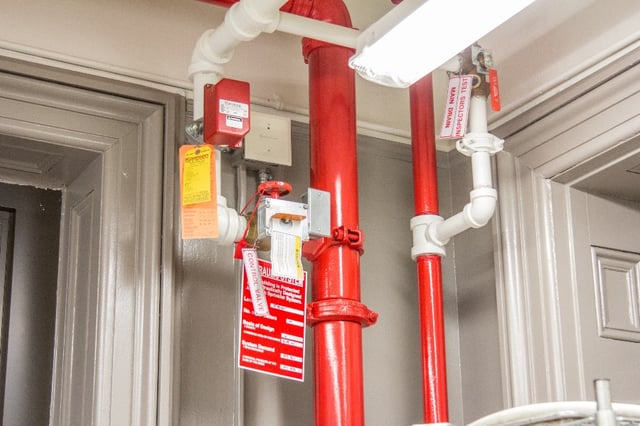Maintenance Schedule of Fire Sprinkler Systems
Fire sprinkler inspection schedules are determined by the local code enforcement. Typically, you will find fire sprinkler inspections are required annually, semiannually, quarterly and sometimes monthly. The inspection schedule is determined by the local code, the building occupancy type, and which components are used in the fire sprinkler system. For instance, in a high-rise you will normally find a fire pump, which boosts the pressure of the fire sprinkler system in order to ensure the proper water pressure is reached even at the very top of the building. A fire pump changes the fire sprinkler requirements and the schedule.
Writing the Local Code for Fire Sprinkler Inspections
The local code is dictated by the National Fire Protection Association’s code NFPA 25, which is the standard for the inspection, testing, and maintenance of water-based fire protection systems. The International Building Code (IBC) is also used to shape the local codes for fire sprinklers. Each state and jurisdiction have their own additions to the standards adopted from NFPA 25 and IBC.
In some states, local jurisdictions may enhance the state code while in other states, like Pennsylvania, there is no state code. In Pennsylvania, each jurisdiction creates their own codes, which can be difficult for companies that do business in more than just one jurisdiction.
Inspection vs Testing
Many people tend to use the word “inspection” when describing both fire sprinkler inspections and fire sprinkler testing. However, when interpreting and following the local codes and NFPA 25, there is a difference between inspections and testing. An “inspection” requires the technician to visually inspect the device, like a sprinkler head. Sprinkler heads are inspected for leakage, corrosion, paint, orientation and clearance below the sprinkler head. If the sprinkler head looks normal and it is not obstructed or has anything within 18 inches of the deflector, it usually passes inspection.
“Testing” a fire sprinkler system is when a technician tests the function of the fire sprinkler components. For instance, a technician will test the function of a butterfly valve by opening it to check for proper water flow and pressure. Since many fire sprinkler systems are tied into the fire alarm panels, there are additional testing requirements to ensure the fire alarm panel is activated when testing the fire sprinkler system.
Required Maintenance for Fire Sprinklers After Fire
If a fire sprinkler head is activated as a result of a fire, not only does that fire sprinkler head need to be replaced, but so does every fire sprinkler head that is in the same room or vicinity of the fire. Once the sprinkler heads are replaced with new ones, a water flow test and a valve test are performed to ensure the system is operating correctly and the pressures are correct.
Proof of Fire Sprinkler Inspections and Testing
A Fire Marshal or Authority Having Jurisdiction (AHJ) may ask for documentation that the required inspections and testing of fire sprinklers have been performed. Koorsen provides their clients with an Inspection and Testing Report that details what has been inspected and tested and when it was completed. The report includes the pressure readings and the flow times for every riser, inspection tag dates, and documentation that every sprinkler head was clean and unobstructed.
Typical Schedule of Fire Sprinkler Inspections, Testing & Maintenance
According to NFPA 25, below are the recommended schedule for fire sprinkler inspections, testing, and maintenance. These may change according to updates to NFPA 25 and additions to the local code.
WEEKLY/MONTHLY
- Inspection of gauges and control valves in dry, wet pipe, pre-action, and deluge systems.
QUARTERLY
- Inspection of alarm devices, hydraulic nameplate, and fire department connections.
- Testing of alarm devices and main drain.
ANNUALLY
- Inspection of hanger/seismic bracing, pipe and fittings, spare sprinklers, signage, and sprinklers.
- Testing of main drain, water flow, fire pump, antifreeze solution, alarm devices, deluge, and pre-action valves.
- Maintenance of valves and low point drains in dry pipe systems.
To schedule service or to learn more about inspections, testing and maintenance of fire sprinkler systems, contact a Koorsen Fire & Security associate today.



